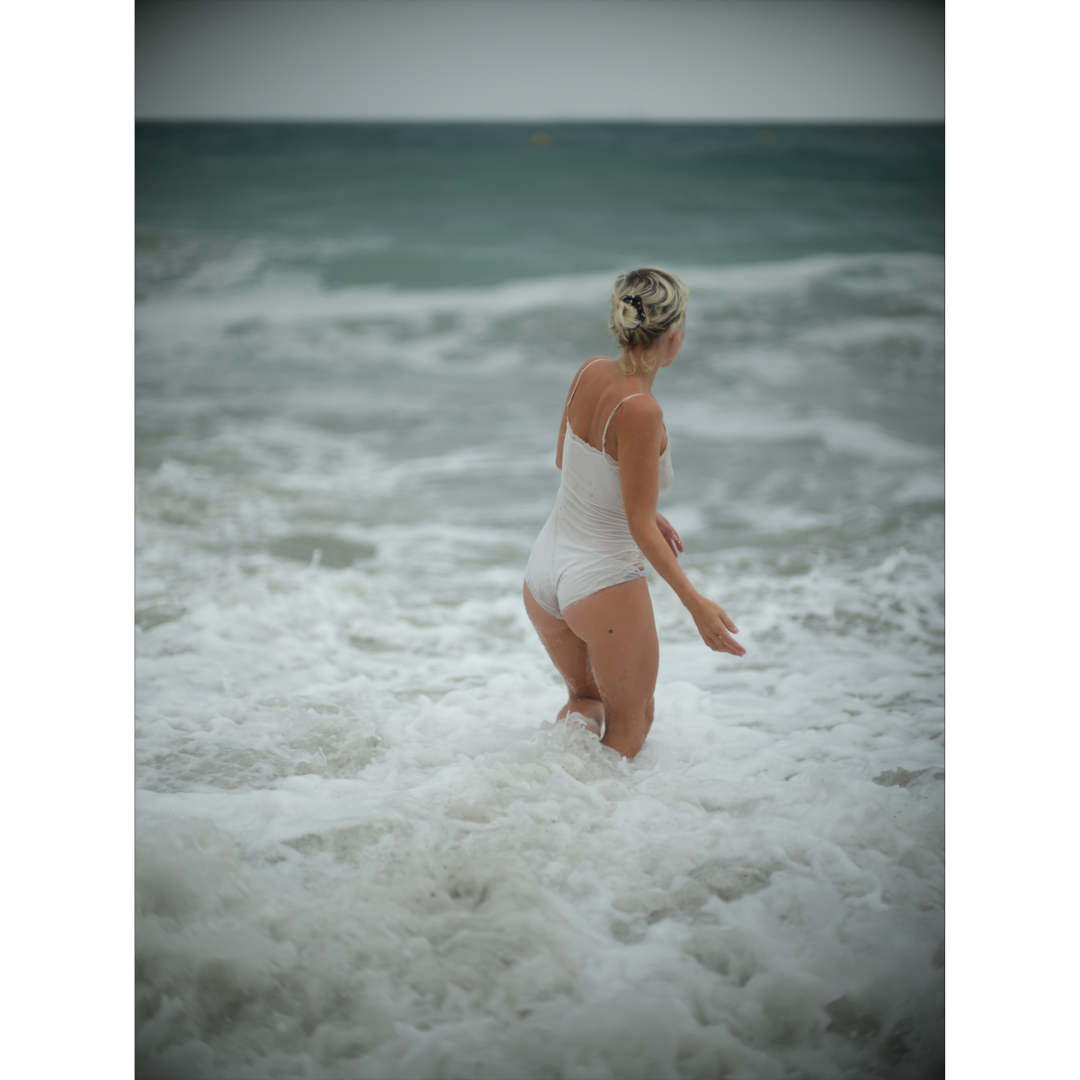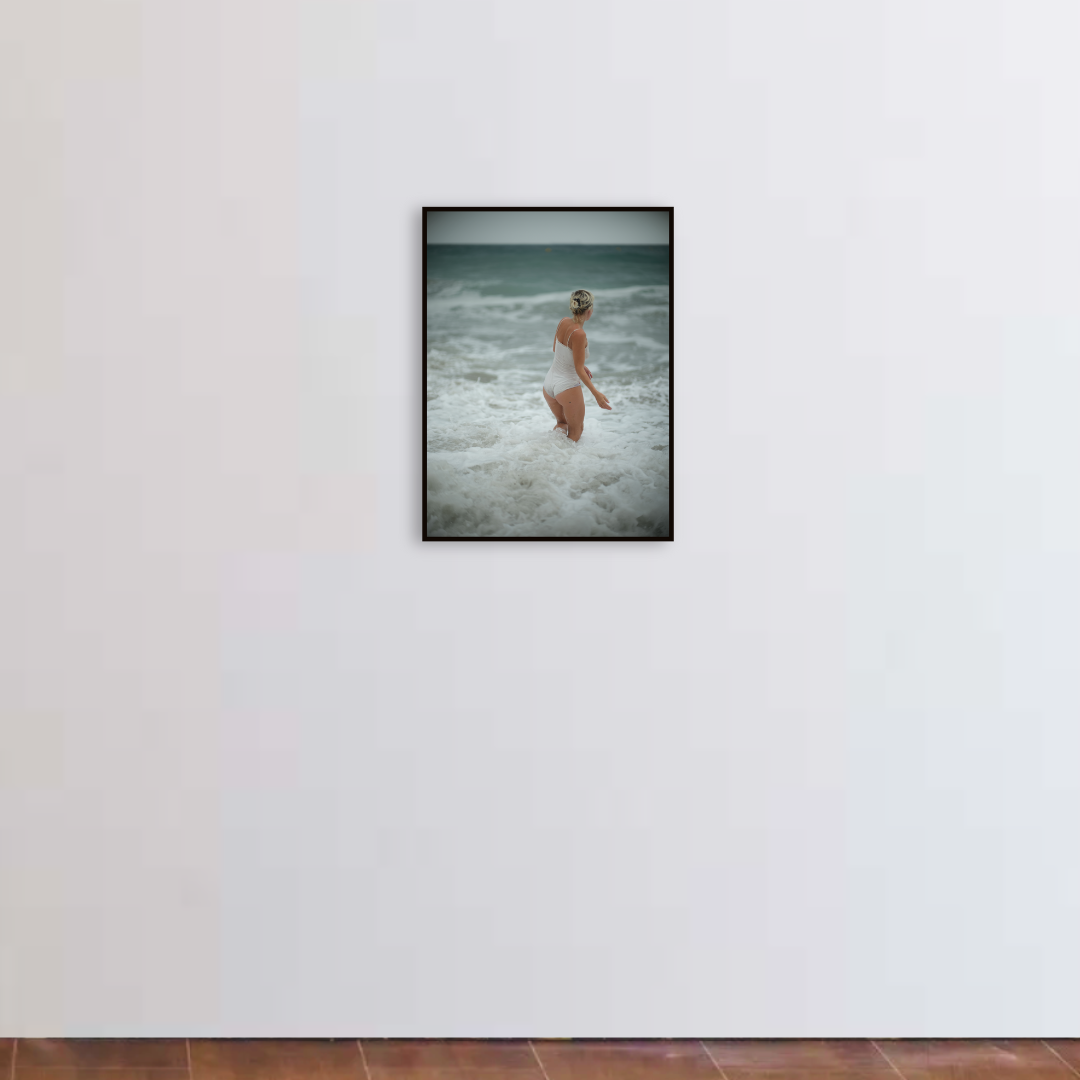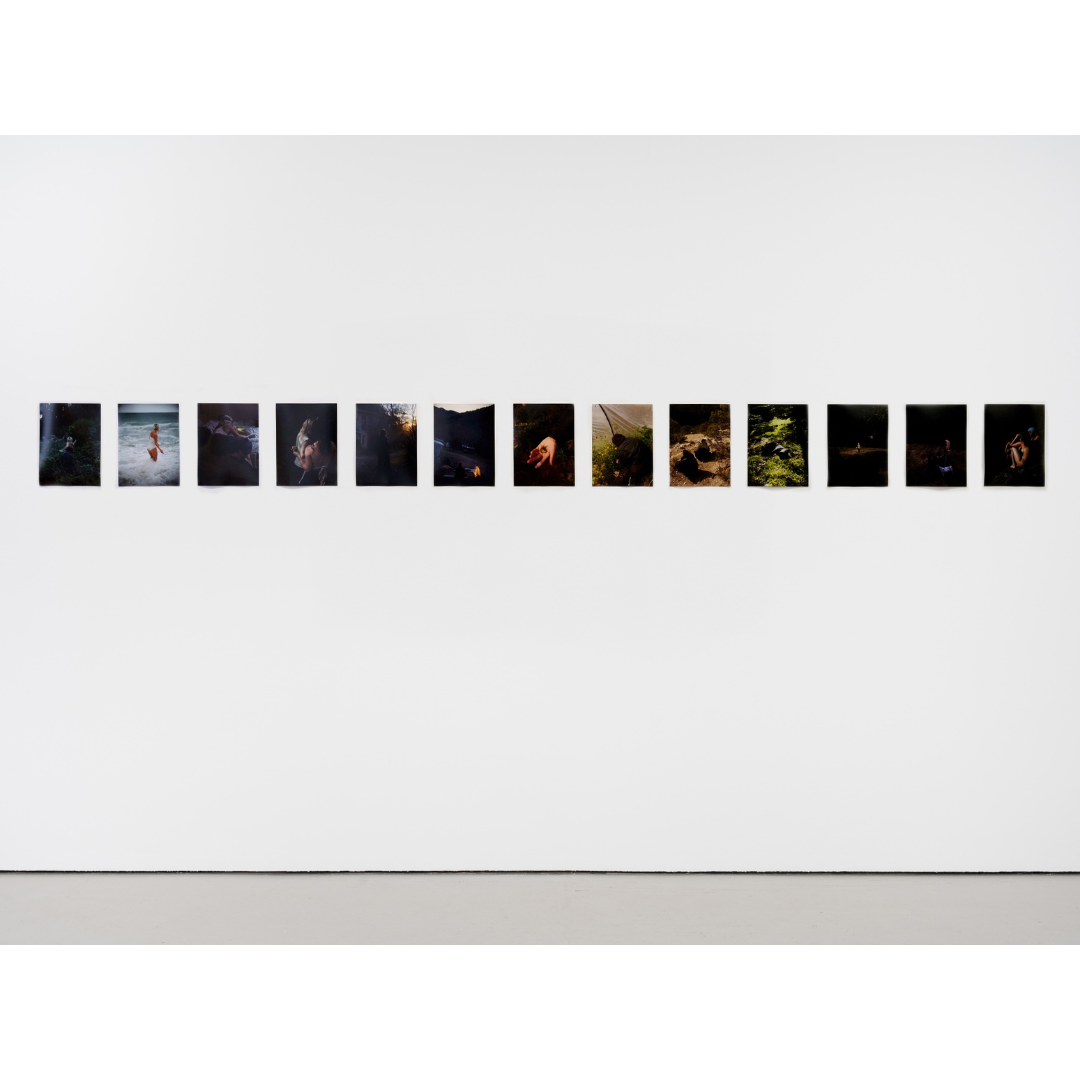






Close Considerations
Spatially configured spiral: Lerma's spiral motif in the composition evokes psychological concerns (Hurley, 1993).1The spatial configuration, with the artist behind the figure caught in the spiral's crashing waves, induces a sense of vertigo. Lerma's disorienting composition intensifies this effect, as the sea's agitation and the subject's centrality and apparent command over and submission to the force of the rising sea leaves the viewer adrift.
Implicated viewer within relational space: The subject ventures into the storm, her gaze fixed on the horizon, her hands gesturing towards the artist behind her. Lerma's approach utilises compositional strategies that transform her pictures into relational spaces, implicating the viewer. The depicted subject, whose identity remain obscured, acknowledge Lerma's presence through a partial body orientation. This angled positioning emphasises the empty spot that the viewer instantly fills, along with their psychological impulses. However, the subject's resigned and unperturbed demeanour, regardless of company, signifies a confident sense of self.
Claustrophobic effect of light: The imagery features subtle, faded light and darkened peripheral zones, a consequence of the camera's exposure settings. This compositional strategy alludes to a sensation of claustrophobia, akin to the psychological pressure exerted by the imminent threat of a storm.
Merging through colouristic relation: The figure's white swimsuit establishes a colouristic relation with the froth of the crashing waves, suggesting an embodiment of the turbulent sea. This visual association imparts a paradoxical sense of tranquillity, as if the figure has attained a state of symbiotic harmony with the aquatic environment.
Against the progression of time through light and space: The image's semantic trajectory unfolds in both temporal and spatial dimensions, transitioning from the nebulous, indistinct background to the sharply defined, illuminated foreground, all while the figure moves against it towards the horizon. This progression is accentuated by the intensification of light, chromatic saturation, and materiality (Nochlin, 1985, p.32).2 The encroaching waves, directed towards the viewer, amplify this transition, the observer as the scene shifts from obscurity and blur to clarity and illumination.
Axis alignment, discontinuities, asymmetries and open frames: The figure's orientation, guided by her head, aligns with the diagonal axis of the white line formed by the first wave, directing the viewer's gaze towards an area beyond the frame. This visual harmony is intentionally disrupted by incorporating discontinuities, asymmetries, and open frames, as John Slyce (2000) describes, where "the frame sets limits while, at the same time, offering a tangible means of escape."3 This disruption is achieved through cropped sections, lines extending beyond the frame, figures interacting with elements external to the frame, and awkward props, all of which break the symmetry and spatial continuity, adding complexity and preventing the composition from becoming overly rigid.
Notes:
1 Hurley, Neil P. Soul in Suspense: Hitchcock’s Fright and Delight. Scarecrow Press, 1993.
2 Nochlin, Linda. Realism. Penguin Books, 1985.
3 Slyce, John. On Time, Performative Realism: The Photographs of Sarah Jones, Museum Folkwang, 2000.




Process
Pre-emptive intuitional composing: Lerma's process involves anticipating and capturing spontaneous configurations among her friends in various spaces, employing intuitive pre-emption to preserve the moment's energy and mystique. She utilises specific camera settings, such as a wide aperture and slow shutter speed, to capture details in dimly lit spaces, contributing to the mood and emotional depth. She strategically positions herself or awaits the ideal light or for her subjects to assume particular poses or interactions, balancing spontaneity with a clear intention regarding the desired capture, resulting in organic yet meticulously crafted compositions.
Unprivileged view: Lerma's compositions align with Tillmans' notion of the "unprivileged view" (Godfrey, 2017),1where the artist's presence minimally influences the scene. Subjects often remain oblivious to Lerma, creating an atmosphere that "provokes a feeling of not mattering rather than command" (Ibid.),2 enabling the viewer to engage with the scene without undue artist interference.
Embedded ethnography: Lerma assumes the role of a "documentary observer," employing a systematic process of observation to allow the landscape to reveal itself without imposition, as articulated by hooks (1997).3 From within the communitas, Lerma offers a literal perspective aligned with Turner's concept of “heroic time,” rendering her an effective anthropologist of her own culture (Turner, 1985).4 Her ethos mirrors the communitas' values, characterised by a spontaneous and immediate approach to relationships. Subjects within the communitas retain the autonomy to approve or withdraw consent for the use of their photographs.
Process as political action: Rancière's (1999)5 framework on the “aesthetics of politics” posits that art transforms into political activity by disrupting the established symbolic order through the exposure of previously invisible elements. Lerma's practice, while intertwined with her political life, differs from photojournalism, which presents events as mere records or spectacles. Conversely, Lerma captures "the image of the photographic rhetoric that is purported to capture the event" (Guerra, 2006),6 offering a comprehensive understanding of the group's actions and underlying processes.
Discontinuities, asymmetries, and open frames: Lerma's breaks the focus by using discontinuities, asymmetries, and open frames enriching this scene by disrupting its visual harmony and preventing rigidity. John Slyce (2000) notes, "The frame sets limits while offering a tangible means of escape."7 Lerma achieves this through cropped sections, leading lines extending beyond the frame, figures interacting with off-frame elements, and awkward props.
Disconnected instants and implicit intertextuality: Lerma's works, presented in artist books with variable image sequences, allow each work to be viewed within diverse contexts. This lack of a fixed sequence creates a dynamic constellation of "disconnected instants" (Berger & Bohr, 1982),8 where juxtaposition generates echoes, contrasts, and recurrences, forming "implicit intertextuality" (Ricœur, 1984).9 While the book format provides a meta-continuation, Lerma's practice of altering the sequence ensures each picture's autonomy, boosting its individual sovereignty.
Iterative composing and tautological reinforcement: Lerma's iterative compositional process generates multiple variants to elucidate the core structure and select the most impactful representation. This tautological approach reinforces the compositional elements' conjunction and interrelationships, as Allison Smith (1998)10 asserts. Despite facial anonymity, Lerma offers hints about her subjects' identities through body language and poses across different tautological contexts, facilitating viewer interpretation of actions and interactions, and engendering a viewer-subject relationship.
Notes:
1 Godfrey, Mark. Worldview. In Wolfgang Tillmans 2017, edited by Chris Dercon, Helen Sainsbury, and Wolfgang Tillmans, Tate, 2017, pp.14-76.
2 Ibid.
3 hooks, bell. “Between Us: Traces of Love—Dickinson, Horn, Hooks.” In Earths Grow Thick, Wexner Center for the Arts, 1997.
4 Turner, Victor. On the Edge of the Bush. 1985.
5 Rancière, Jacques. Disagreement: Politics and Philosophy. University of Minnesota Press, 1999.
6 Guerra, Carles. Notre Histoire, Catalogue of the Exhibition. Paris: Palais de Tokyo, 2006.
7 Slyce, John. On Time, Performative Realism: The Photographs of Sarah Jones, Museum Folkwang, 2000.
8 Berger, John, and Jean Bohr. Another Way of Telling: A Possible Theory of Photography. Bloomsbury, 1982.
9 Ricœur, Paul. Time and Narrative. Translated by Kathleen McLaughlin and David Pellauer, University of Chicago Press, 1984.
10 Smith, Allison. Agnes Varda. Manchester University Press, 1998.




References
Hitchcockian Vertigo: Lerma has cited Hitchcock's cinematic portrayal of vertigo as a strong inspiration. While the spiral in other works makes this more explicit, the dizzying disorientation can result from looking down from the edge, the sense of disorientation and potential loss of control in the face of nature's power, reflecting the psychological disorientation (Hurley, 1993).1 The individuals depicted seem to be in a state of perpetual vertigo that renders them indifferent to the physical elements.
Vinca Petersen: Lea Lerma's reference to Vinca Petersen, the artist and former nomadic squat dweller, highlights their shared experiences. While Petersen's group embraced rave and party culture, Lerma's resonance aligns more closely with Petersen's depictions of interpersonal connection and natural landscapes, capturing moments of ecopsychological euphoria.
Goya’s progression of time through light and space: Goya's Third of May unfolds temporally and spatially within the pictorial field. The narrative progresses from an undifferentiated background, describing the 'before,' to a climactic, light-revealed execution scene, representing the 'now,' and concludes with fallen figures at the pictorial boundary, signifying the 'afterwards.' This temporal progression is boosted by light intensity, colour saturation, and materiality, as noted by Nochlin (1985).2
Surrealism: Similar to the problematic light effects in the works of Delvaux, De Chirico, Ernst, Dali, Tanguy, and Miró, Lerma's work features an unknowable light source that bathes the figures in unnatural scenes that appear staged or digitally manipulated. The forest setting, devoid of any discernible light source, is illuminated by both hard and soft light, casting ominously thick black shadows from architectural elements. This juxtaposition of light and darkness creates a menacing atmosphere.
Andrei Tarkovsky's Landscapes: Tarkovsky's portrayal of humanity in a state of loss within natural landscapes is recalled in Lerma's work, which, through her community's actions, evokes a similar sense of being enveloped by expansive and immersive scenes. Lerma's compositional structures echo Tarkovsky's landscape aesthetics. (Image: Tarkovsky’s still from Stalker)
Caspar David Friedrich’s romanticism: Friedrich Schleiermacher, a contemporary of Caspar Friedrich (whom Lerma cites as an influence), redefined religion as an internal, instinctual experience, departing from doctrinal interpretations (Butin, 2014).3 While Friedrich's and Lerma's works depict nature, this particular picture of Lerma’s subverts the traditional hope of transcendental possibilities. Instead, it presents a state of oblivion, akin to imminent psychological death and complete disillusionment, yet replete with potential dopamine and serotonin effects. (Image: Caspar David Friedrich’s Wanderer above the Sea of Fog, 1818.)
Clement Cogitore's Work: Cogitore, another reference point of Lerma’s, explores themes of irrationality, archaic schemas, primitivism, sacred survival, magic's infiltration into a world losing faith in transcendence, and apocalyptic figures. Ancient forms are recontextualised through contemporary image perception, where technology and the internet have replaced magic, yet the unconscious remains in pursuit of belief (Vergne, 2018).4 (Image: Clément Cogitore, We are Legion, 2012. Courtesy of the artist.)
Fairytales: Lerma's visual narrative draws from historic fairytales, featuring ordinary protagonists immersed in fantastical realms (Swann Jones, 2013).5 Like Red Riding Hood and Snow White, Lerma's protagonists are young adults transitioning into adulthood, venturing into uncharted territories (Lüthi, 1976)6 and defining themselves (Flores, 1996).7Fantastical elements in Lerma's work facilitate suspension of disbelief (Vasudeven, 2017).8 The depicted moments remain authentic, subtly altered by Lerma's presence, perspective, and technique, creating a captivating dissonance in the fantastical scenes grounded in reality.
Sarah Jones and Dutch-Flemish Painting: Lerma's works, including this one, often exhibit structural configurations similar to Jones's pictures and Dutch-Flemish painting. Figures appear deeply engrossed, while settings pulsate with subtle significance (Higgie, 2000).9 A system of micro-signs forms a psychological narrative, with hints found in hand and foot positioning (Troncy, 2000).10 Lerma's brilliance lies in the silent interplay of places, objects, and people, which convey the intensity of a Greek drama (Higgie, 2000).11
Rembrandt, Caravaggio and Vermeer: Lerma's work resonates more with Rembrandt than Caravaggio or Vermeer, all of whom she mentions in discussing her practice. Her figures though caught in chiaroscuro-like moments and in quiet poses of Vermeer, exhibit Rembrandt’s quality of calm yet bold receptivity and a sense of awe towards the potential for transcendence within the ordinary. The evanescent light on the figures, sometimes subtle and other times radiant, imbues them with a mystical connection.
Nan Goldin: Lerma's work is influenced by Nan Goldin's exploration of intimate relationships, capturing moments of isolation, self-revelation, and adoration (Sussman, 1996).12 However, Lerma's approach differs from Goldin's photojournalistic snapshots, as Lerma's work is meticulously composed through pre-emption and tautology, resulting in a unique, rigorous, and more metaphysical visual language.
Notes:
1 Nochlin, Linda. Realism. Penguin Books, 1985.
2 Butin, Hubertus. Gerhard Richter’s Editions and The Discourses of Images. In Gerhard Richter Editions 1965–2013, edited by Hubertus Butin, Stefan Gronert, and Thomas Olbricht. Hanje Cantz, 2014.
3 Vergne, Jean-Charles, and Clement Cogitore. Le Prix Marcel Duchamp. SilvaneEditoriale, 2018.
4 Swann Jones, Steven. The Fairy Tale: The Magic Mirror of the Imagination. 1995.
5 Lüthi, Max. Once Upon a Time: On the Nature of Fairy Tales. F. Ungar Pub. Co,1976.
6 Flores, Nona C. Animals in the Middle Ages: The Book of Essays. 1996.
7 Vasudeven, Alexander. “Reassembling the City: Makeshift Urbanisms and the Politics of Squatting in Berlin.” The Autonomous City: A History of Urban Squatting. Verso, 2017.
8 Higgie, Jennifer. Sarah Jones. Le Consortium, 2000.
9 Troncy, Eric. Sarah Jones. Le Consortium, 2000.
10 Ibid (8)
11 Sussman, Elisabeth. Nan Goldin: I’ll be Your Mirror. Whitney Museum of American Art, 1996.



